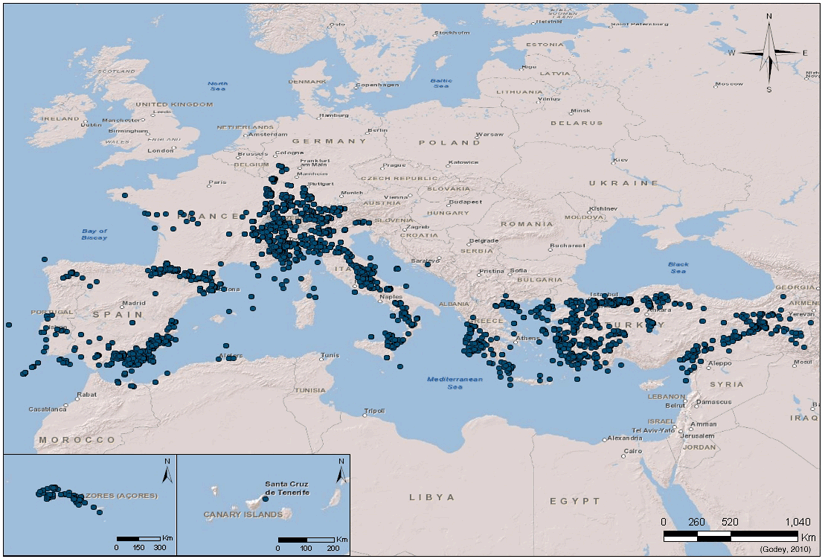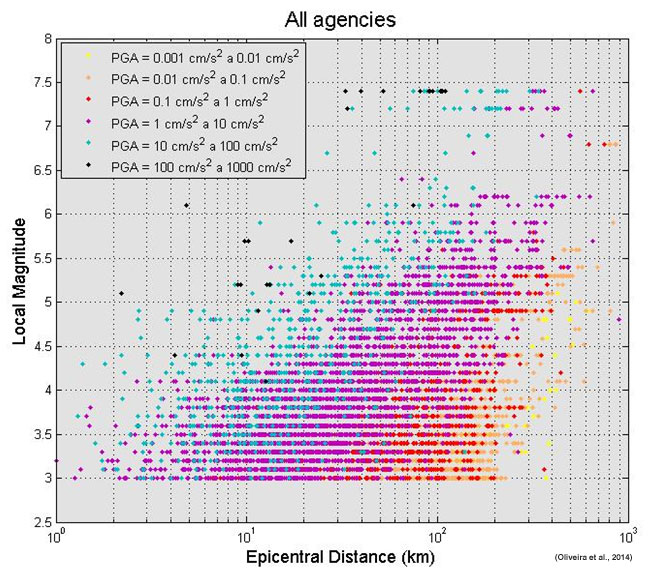Introduction
In the absence of an archive for recent digital European data, the NERIES Project (2006), acting under a Networking Activity (NA5), aimed at developing a distributed database of accelerograms to provide open waveforms data, among many other topics, to the scientific and engineering communities. This effort was successful during the duration of the NERIES Project and covers strong motion (SM) activity for the period 1996-2010.
To achieve this goal, several tasks were developed by the agencies participating in the NERIES Project (IGC, Institut Geològic de Catalunya; IST, Instituto Superior Técnico; ISTerre, Institut de Sciences de la Terre; KOERI, Kandilli Observatory and Earthquake Research Institute; ITSAK, Institute of Engineering Seismology and Earthquake Engineering; and ETHZ, Swiss Federal Institute of Technology):
- A detailed characterization of the recording instruments and the sites of the accelerometric stations;
- Development of computer software (PARAMACC) to determine, in a homogenized manner, a collection of waveform parameters of interest for engineering;
- Development of a web portal (Earthquake Data Portal, 2011) to manage the access of users to retrieve parameter values and waveform data (Roca et al., 2011; Péquegnat et al., 2011).
The prototype distributed database of accelerogram waveforms, is not more available since 2013. After the conclusion of NERIES, other on-going projects, ORFEUS (2013) and EMSC-CSEM (2013), are being developed to continue the efforts to collect SM information and store waveform data. The latest developments led to the beta version of the Rapid Raw Strong Motion (RRSM, 2014) system, which automatically aims at delivering strong motion products in near-real-time for earthquake scientists and earthquake engineers.
During NERIES project and in parallel to the prototype distributed database of accelerogram waveforms we have compiled, in an events-parameters-soil table, containing the information related to earthquake sources (magnitude and epicentral distances to recording stations), soil conditions and ground motion waveform parameters (PGA, PGV, AI, TD, CAV and HI, together with PSV(f) for 28 frequencies), which were computed by each agency using the same software.
Data sets contributing to the present proposed “Events-Parameters-soil Table”
The data assembled in the database as of December 2010 refer to records since 1996 that belong to the above mentioned six different European networks as well as a set of Italian data (Italian Accelerometric Archive - ITACA 2010) and data from Spain (Instituto Geográfico Nacional - IGN 2010). Approximately 6,000 three-component records from 547 stations associated with 2,629 events with 3.0<M<7.4 and epicentral distances (0-863 km) were assembled for this work.
A simple classification of the soil conditions associated with each station (Rock, R, Hard, H, and Soft, S) is available for all of the contributing agencies; however, a more detailed soil classification based on EC8 (2004) classes (A, B, C, D and E) exists for the ITDPC- Dipartamento della Protezione Civil Italiana, RAP- Réseau Accélérometrique Permanent, KOERI and IGN stations.
These records, which correspond to 2,629 events with 3.0<M<7.4, were disaggregated by network, as shown in Table 2, with reference to the time interval of events and the range of magnitudes.
All the details of processing and selection of data can be found in Roca et al. (2011)
The “Events-Parameters-Soil" Table (©Excel Microsoft) was created to perform a complete analysis of the data (Oliveira et al., 2014). Each row of the table lists all of the information for each individual component. The whole table, containing 19,961individual components can be downloaded (excel format, 15 MB).
The fields in the Event-Parameter-Soil Table are the following:
- A. Record-Register: identification header
- B. Network
- C. Component
- D. Station Code
- E. Earthquake Date
- F. Epicenter Longitude
- G. Epicenter Latitude
- H. Ml: Agency Local Magnitude
- I. PGAU: uncorrected PGA (cm/s2)
- J. PGAC: corrected PGA, (cm/s2)
- K. AI: Arias Intensity (cm/s)
- L. TD: Trifunac Duration (s)
- M. CAV: Cumulative Absolute Velocity (cm/s)
- N. PGV (cm/s)
- O-AP. PSV(f) 5% damping for 28 frequencies (from 0.15 Hz to 39 Hz)
- AQ. HI: Housner intensity (cm)
- AR. DEpi: Epicentral Distance (km)
- AS. Soil Type R, H, S
- AT. EC8 Soil class A, B, C, D, E from geology
- AU. EC8 Soil class A, B, C, D, E from Vs30
- AV. Vs30 value (× and O means no data)
Acknowledgements
The work to compute the “Events-Parameters-Soil Table” has been partially supported by the EC Project NERIES, Sixth Framework Programme, Contract number: RII3-CT-2006-026130. Special thanks are due to all of the authors’ institutions for financial support.
The authors would like to acknowledge all of the networks that contributed their data, including the French RAP (Réseau Accelerometrique Permanent), represented by ISTerre. Their representatives, C. Zulfikar (KOERI), C. Papaioannou (ITSAK), P. Guéguen (ISTerre), J. Clinton (ETHZ), L. Luzi (ITDPC), L. Cabañas (IGN) and S. Godey (EMSC) have contributed to the computation of the parameters contained in the Table. The Table was assembled by G. Gassol and the Webpage prepared by J. Fleta (ICGC).
References
• Earthquake Data Portal (2011). Earthquake Data Portal 2011, www.seismicportal.eu (accessed in March 2011).
• EC8 (2004). “Eurocode 8. Design of Structures for Earthquake Resistance. General rules, seismic actions and rules for buildings", BS EN 1998-1:2004.
• EMSC-CSEM (2013). Euro-Mediterranean Seismological Centre, www.emsc-csem.org (accessed in Feb 2013).
• Oliveira, C.S.; Gassol, G.; Goula, X. and Susagna, T. (2014). A European Digital Accelerogram Database: Statistical Analysis of Engineering Parameters of Moderate Magnitude Events. Earthquake Engineering and Engineering Vibration (Vol. 13, no. 4, pp. 583-597. DOI:10.1007/s11803-014-0265-6).
• ORFEUS (2013). “Observatories and Research Facilities for European Seismology", www.orfeus-eu.org/ (accessed in Feb 2013).
• Péquegnat, C.; Guéguen, P.; Hatzfeld, D. and Langlais, M. (2008). “The French accelerometric network (RAP) and national data center (RAP-NDC)", https://citeseerx.ist.psu.edu/viewdoc/download?doi=10.1.1.819.3309&rep=rep1&type=pdf (accessed in Jan 2010).
• Roca, A.; Guéguen, P.; Godey, S.; Goula, X.; Susagna, T.; Péquegnat, C.; Oliveira, C.S.; Clinton, J.; Papaioannou, C. and Zulfikar, C. (2011). “The Euro-Mediterranean distributed accelerometric data-base”. in: S. Akkar, P. Gulkan and T. Van Eck editors, Earthquake Data in Engineering Seismology. Predictive Models, Data Management and Networks. Geotechnical, Geological and Earthquake Engineering Book Series, Springer, Chapter 9. pp. 115-128.
• RRSM (2014). “Rapid Raw Strong Motion system", http://www.orfeus-eu.org/rrsm/information (accessed in Sept 2014).

 Contact
Contact









